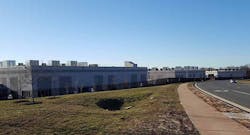Amazon Web Services has confirmed plans to build another 12 data centers across its three campuses in Ohio, and says it could build additional campuses in the state if it can get a deal on its electricity costs.
Amazon discussed its cloud infrastructure ambitions in a filing with Ohio regulators, tying its expansion goals to the need to reduce its cost of power. The company is seeking unspecified discounts from Ohio utility American Electric Power (AEP), as well as the ability to procure energy from third parties if it can find cheaper or greener electricity.
“The potential for investment in and development of additional Ohio data centers could support thousands of new jobs and hundreds of millions of dollars of increased regional income and GDP in Ohio’s 21st Century knowledge economy,” said Charles Daitch, Manager of Energy Initiatives for Amazon, in the filing.
The disclosure follows the news that Amazon Web Services (AWS) is working with developers to add up to 11 new data centers in Northern Virginia, where it already operates about 30 data centers to support its US East cloud computing operation.
It also continues the massive investment in cloud infrastructure in the Central U.S., a trend driven by the need to reach more Americans with latency-sensitive online services.
Power Discount Could Bring More Cloud Campuses
Amazon Web Services hosts most of its infrastructure in three regional data center clusters, in Virginia, Ohio and Oregon. Ohio has become a key strategic location for Amazon’s cloud computing operation, hosting the western cluster of the US East region. In the first phase of operations, AWS invested $1.1 billion to build data center campuses in three locations: Dublin, Hilliard and New Albany. Each campus currently houses one working data center, with land to support up to four more.
The company has always indicated the potential for as many as five data centers on each campus. But the regulatory filing, which will be considered in a Tuesday meeting of the Public Utilities Commission of Ohio, suggests the company is preparing for its next round of investment. The key details in the filing – including proposed rate discounts and Amazon’s energy usage and investment plans – are all redacted from the regulatory filing, citing a confidentiality request from Amazon.
The proposal calls for AWS to receive usage-based discounts on power provided by AEP, as well as the ability to buy energy from other providers. These “direct access” programs are increasingly common, allowing large customers to procure the cheapest and greenest power available on the open market, while compensating the local utility for the use of its transmission network to deliver that power. Amazon also indicated it plans further investment in substations to connect with AEP’s 138kV power transmission network.
In the filing, Amazon raised the prospect that it could expand elsewhere if discounts are not available. The proposal is ” intended to align Vadata’s cost structure with its relatively unique load profile and characteristics making the Ohio region competitive with our other data center regions,” Daitch said in the filing by Amazon affiliate Vadata. “Many of the data center capital and operating costs are similar across U.S. regions, and data centers in Ohio will be competing for growth with other low energy price regions in the U.S.”
But Amazon also indicated that competitive pricing could bring additional cloud campuses to Ohio.
“There is even greater long-term potential for additional data center development beyond these three campuses as enterprises migrate more and more of their IT resources to the cloud,” AEP said in its filing. “If the Ohio Region grows – with more data centers on existing campuses and potentially additional campuses – Amazon will remain open to options to expand its presence in Ohio.”
Cloud Boom Continues in the Midwest
Amazon’s Ohio investment is part of a data center building boom in the Midwest, pumping billions of dollars into towns across America’s heartland. Five large cloud companies – Apple, Google, Amazon, Microsoft and Facebook – are investing more than $11 billion to build massive server farms across Iowa, Ohio and Nebraska.
These cloud campuses concentrate massive amounts of computing power in multiple data center buildings, enabling cloud companies to rapidly add IT capacity and electric power, creating economies of scale as more workloads migrate into these massive server farms.
Placing these data centers in the center of the country makes it easier to distribute content to major markets like Chicago and Dallas, reducing lag and buffering for streaming media like Netflix movies or Facebook videos. It also allows for data to move quickly to either coast, which can be important in application development.
As an example, Amazon Web Services customers using the company’s Ohio data centers experience just 12 milliseconds of round-trip latency when sending data to the cluster of AWS facilities in Northern Virginia. This makes it easier for customers to replicate data across the two regions, which allows for automatic failover when web applications experience performance problems or outages.
Although the details of Amazon’s regulatory filing are confidential, the company’s plans suggest a ballpark of of between 450 and 480 megawatts of data center capacity Initial plans filed with Ohio municipalities indicate that each campus will include up to five data centers, each backed by 18 backup generators (2.5 megawatt units). That suggests power capacities of about 32 MW per facility, near the upper end of the 25 to 30 megawatt design standard for data centers outlined by Amazon’s James Hamilton.
By that math, AWS has a potential long-term buildout of between 450 and 480 megawatts of data center capacity – or more than 750,000 physical servers.
About the Author



